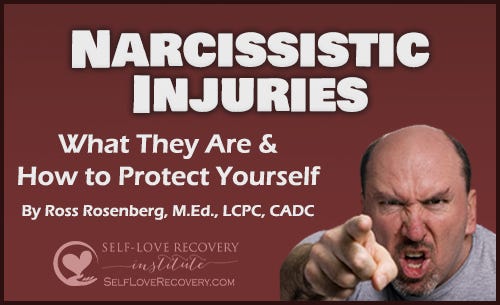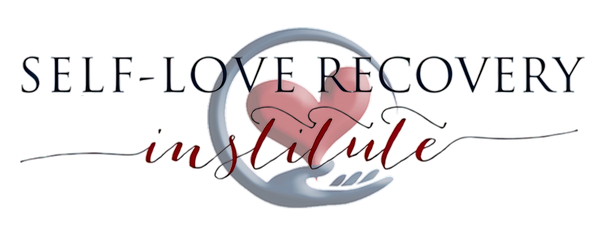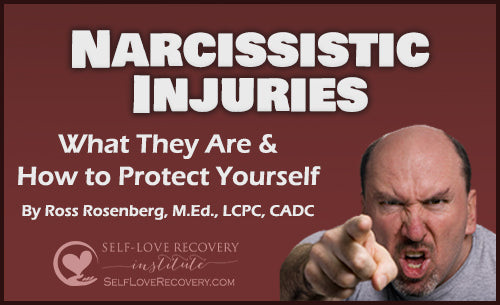 Written by Ross Rosenberg, M.Ed., LCPC, CADC
Written by Ross Rosenberg, M.Ed., LCPC, CADCSelf-Love Recovery Institute – President/CEO
Psychotherapist, Educator, Author, Expert Witness
A narcissistic injury occurs when narcissists react negatively to perceived or real criticism or judgment, boundaries placed on them, and/or attempts to hold them accountable for harmful behavior. It also occurs when a person does not accommodate a narcissist’s insatiable need for admiration, special privileges, praise, etc. The “injury” also shows up when the narcissist over-amplifies and personalizes benign interpersonal interactions, or when a person with no mal-intentions does not meet the narcissist’s impossible-to-achieve desires for high levels of praise and admiration.
The narcissist’s loss of control over their emotional equanimity and a subsequent burst of passive or overtly aggressive vindictive responses follows their narcissistic injury. These bouts of emotional tumult are referred to as emotional dysregulation, as the activated narcissist’s emotional reaction spikes and often is beyond their control.
In my book, The Human Magnet Syndrome: The Codependent Narcissist Trap, I explain how the loss of emotional control and the reflexive need to punish an “offending” person can be traced back to the narcissist’s core shame and pervasive levels of pathological loneliness, about which the narcissist is often either in denial or oblivious (dissociated from).
This hair-trigger “injury” reaction is a direct result of attachment trauma the narcissist suffered as a child, often because of an abusive, neglectful, or depriving narcissistic parent. Unlike the distressing nature of attachment trauma experienced by a child who becomes an adult codependent, the agonizing childhood attachment trauma of a child who is to become a Pathological Narcissist is far worse.
In Chapter Nine of The Human Magnet Syndrome, The Origins of Pathological Narcissism, I explain that the immense abuse, neglect, and/or deprivation perpetrated by both the Pathological Narcissist parent, and to a significantly lesser degree, the codependent parent, results in psychological trauma of the highest degree. To emotionally survive this anguish, the child’s mind reacts in a manner similar to adult victims of Posttraumatic Stress Disorder (PTSD). When a traumatic event is beyond the brain’s ability to process, sort through, and integrate as an experience of severe trauma, it is relegated to what many people refer to as our unconscious mind.
The human brain has a circuit breaker-like response to trauma. In other words, a natural safety mechanism that is activated when any given traumatic event(s) exceeds the brain’s capacity or is overloaded. The “circuit” is “tripped”, and the traumatic experience is relegated to a part of the brain that deeply buries these memories. In other words, the trauma is neatly packaged in what I refer to as a “hermetically sealed memory container,” which is physically located in the brain’s limbic system, specifically the amygdala. Once buried, the trauma memory is disconnected from a person’s conscious abilities to recall the event and/or experience the emotions surrounding it.
Underneath the Pathological Narcissist’s psychological “surface,” lies a deeper reservoir of self-loathing and core shame. Although the attachment trauma is blocked from the narcissist’s conscious recollection, they show their “ugly face” during narcissistic injuries. More often than not, defense mechanisms successfully protect pathological narcissists from realizing the truth about their highly traumatized, shame-based, and psychologically impaired selves. This form of “protective amnesia” wards off personal meltdowns (emotional dysregulation) by the psychological processes known as defense mechanisms. Such mechanisms include conversion, denial, displacement, fantasy, intellectualization, projection, rationalization, reaction formation, regression, repression, sublimation, and suppression.
Since the human brain was designed through the imperfect process of evolution, and not by computer programmers, neurologists, or mechanical engineers, the brain’s natural defense mechanisms by themselves are not insufficient in keeping stowed away trauma memories from “bubbling up” into the narcissist’s conscious mind. Despite the brain’s best efforts to keep the trauma cordoned off from consciousness, the “seals are broken,” and there is “leakage.”
The activation or re-surfacing of the trauma manifests as feelings of danger, insecurity, and extreme discomfort, which then trigger a cascade of angry second-level emotional responses, such as hatred, resentment, and/or disgust for the “perpetrating” individual. The resulting emotional dysregulation, at most, is just a temporary solution to the narcissist’s misperceived threat.
Although the hair-trigger reaction emboldens and protects the narcissist, it is only temporary. Like a loosely fitted bandage, it will eventually fall off — exposing the underlying wound (core shame). This is when defense mechanisms kick back into action, and once again divert the narcissists away from their core shame, and toward their grandiose and entitled dissociated selves.
Narcissistic injuries are almost always projections, which is the misplacement of the narcissist’s unconscious self-hatred onto any person who they experience as threatening. Feeling “bad,” “broken,” and/or “never good enough,” as they did as a child, is simply not an option for the Personality Disordered narcissist.
Projections are dissociated feelings of self-hatred and self-loathing, that are attributed to a person who threatens the narcissist’s veneer-thin self-esteem. In other words, projection diverts the realization of self-hatred and core shame by transferring self-judgment and condemnation onto the activating or ‘injuring” person. Because projections intertwine with narcissistic injuries, it is only academic to separate them.
Narcissistic injuries are quite varied. They range from active aggression, like a disapproving glance or kick in the shin, to passive aggression, which includes the silent treatment or triangulation of others against the “injuring” person. A narcissistic injury may even occur when the recipient of the abuse does absolutely nothing. It is the perception of a threat that causes the internal emotional meltdown, not the real thing!
Whether it is yelling, threatening, or even highly dangerous aggressive actions, narcissistic injuries are unnerving to many and downright frightening to most. They provoke an internal fury that incites punishing pronouncements, judgments, and actions against the perceived perpetrator. The only real cure for them is to find an exit route to the interaction and potentially out of the relationship.
Unfortunately, people who suffer from codependency, or what I now refer to as Self-Love Deficit Disorder™, find themselves powerless to Pathological Narcissists. The reason for their attraction to narcissists and their inability to extricate themselves from harmful relationships with them is explained in full in my book, The Human Magnet Syndrome: The Codependent Narcissist Trap. Sadly, those with Self-Love Deficit Disorder mistake the abuse for love and explain away their harm (trauma) by using some of the same defense mechanisms mentioned above.
And remember this: few narcissists learn from the consequences of their out-of-control narcissistic injuries. Any act of contrition or remorse is just a guise to hide their fear of being abandoned by the very person to whom they are causing so much suffering. It is a psychological fact: few narcissists learn from the outcomes of their abuse. And when confronted about it, they do not experience empathy, as they feel justified in their actions.
10 Tips to Protect Yourself from a Narcissistic Injury
- Always protect yourself and your children from unacceptable harm that results from a narcissistic injury. If necessary, contact the police.
- Remember, narcissistic injuries are rarely about you, but rather about the narcissist himself. My video, “It’s Not About You. It’s About Them!” explains this phenomenon.
- Apply my Observe Don’t Absorb Technique, which is explained in my seminar of the same name.
- As much as possible, do not react defensively to the narcissistic injury, as to do so will antagonize the perpetrator of abuse.
- Whenever possible, find an escape route, as narcissistic injuries and the harm that follows, are meant to hurt the projected perpetrator — you!
- Find a good therapist who can help you uncover why you have subjected yourself to the narcissist’s harmful treatment.
- When in psychotherapy, consider discussing how and why the absence of self-love and core shame is at the root of your codependency, or Self-Love Deficit Disorder.
- Explore my Self-Love Recovery, Self-Love Deficit Disorder™, and Codependency Cure™ material to assist you in self-protection and personal and psychological recovery.
- When you find yourself forgiving the offending narcissist, consider that you are more afraid of being alone/lonely than being hurt again. My full-length seminar on Codependency Addiction and Pathological Loneliness can help.
- Learn the Tips, Tools, & Strategies to Overcome Narcissistic Abuse of my Fifty Shades of Pathological Narcissism webinar series.
About Ross
Ross Rosenberg M.Ed., CADC, is Self-Love Recovery Institute’s CEO and primary contributor. His internationally recognized expertise includes pathological narcissism, narcissistic abuse, and attachment trauma. Ross’s “Codependency Cure™ Treatment Program” provides innovative and results-oriented treatment.
Ross’s expert educational and inspirational seminars have earned him international acclaim, including his 23 million YouTube video views and 250K subscribers. In addition to being featured on national TV and radio, his “Human Magnet Syndrome” books sold over 150K copies and are published in 12 languages. Ross provides expert testimony/witness services.
More about Ross and his educational and inspirational work can be found at www.SelfLoveRecovery.com.
Join us on Facebook, Instagram, Twitter, and now TikTok!
https://www.facebook.com/TheCodependencyCure
https://www.instagram.com/rossrosenberg_slri
https://www.twitter.com/rossrosenberg1
https://www.tiktok.com/@rossrosenberg1


0 comments